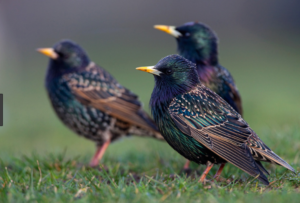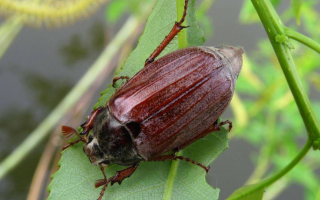Content
- 1 What the May beetle and its larvae look like
- 2 Where the beetle lives
- 3 Why is the May beetle useful?
- 4 What harm does the beetle bring
- 5 Prevention of the appearance of the May beetle
- 6 How to get rid of beetle larvae
- 7 Methods for dealing with adult May beetles
- 8 Preparations for May beetles
- 9 Conclusion
The May beetle is a large insect that lives in a vast range in Europe and Western Asia. It feeds on agricultural crops and is a pest. Before the widespread use of pesticides, it devoured a huge number of productive plants. After the use of poisons, many insects died, and only after limiting the amount of pesticides used, the population began to recover. It is worth making out what are the benefits and harms of the May beetle for gardeners.
What the May beetle and its larvae look like
The length does not exceed 3 cm, the body is elongated. Insect elitres are usually brown. Many short villi are located along the entire length of the body. Sexual dimorphism of pests is presented in formation on antennae. The wings are poorly developed, however, it flies well enough. Emits a strong hum during flight. Travel speed is high enough for dimensions.

Harm to fruit crops is caused not only by mature individuals, but also by undergrowth. The typical popular name for underdeveloped insects that have not undergone a morphological change is Khrushchev. Similar in appearance to an ordinary caterpillar, with 3 pairs of legs on the front of the body. Khrushchev has the following features:
- the head is red, small in size, round in shape. It has rather powerful jaws, due to the properties of which the beetle eats up root crops;
- the rear part of the body is dark, usually brown. This property is provided by a large deposition of feces in the intestine.
Where the May beetle lives
On the territory of Russia and the CIS, 2 subspecies live:
- west;
- Oriental.
They differ in shape, color of the abdomen, pattern of the mustache. The usual habitat of Western May beetles is meadows and glades, surrounded by plantings exclusively in the warm season. The properties of the digestive apparatus of the eastern subspecies provide a preference for life exclusively under the crowns of deciduous trees.
They prefer to settle in forests, wooded steppes, they feel good in plantations of young fruit trees. There is little benefit to plants from such a neighborhood. They can also live among the coniferous representatives of the flora. The love for fir trees arose due to the fact that they grow poorly on solid ground. And the property of parasites is such that it is much easier for them to live inside soft soils than clay soils.
The larvae live underground. The main diet is the root systems of plants, which are located next to burrows. The period of development to an adult is quite difficult, it takes from 3 to 5 years, depending on the ambient temperature. In warmer regions, beetles develop rapidly. Before transformation, there is a process of transition to the state of the pupa, which reaches maturity in a few months.
The characteristic time of the appearance of the parasite is early spring, the life span does not exceed several months. During this time, they manage to mate, create a clutch of eggs and die.
Why is the May beetle useful?
The benefits of the beetle in nature are the large amounts of crude protein that includes the body of the insect. Thus, it is an excellent food for birds, lizards, reptiles and hedgehogs.In addition, the beetle larvae have proven to be excellent bait for fish. It also benefits from attracting attention. Adult beetles are attracted to children and pets, so they often try to catch them. But the beetle larva does more harm than good.
Also in folk medicine, there are recipes that use the body of the parasite as one of the ingredients in decoctions or infusions. According to traditional methods, the remedies help against suppuration, tuberculosis, radiculitis and other diseases.
What harm does the beetle bring
The insect is extremely gluttonous. Therefore, in 1.5-2 months, while the pest is active, it can gnaw shrubs or young trees on the site. The main diet consists of young leaves and buds. A much greater danger is the habit of the larvae eating up the rhizomes of plants. Roots that are thoroughly damaged by young individuals lead to the death of the plant. Therefore, the harm from the May beetle exceeds the benefit.
What crops does the May beetle eat
Typical diet for adults:
- fruit trees, especially cherries, plums, apples, pears;
- bush plants - currants, gooseberries;
- decorative - birch, poplar, linden.
The larvae are much less selective in terms of food, so the harm from them is higher. Khrushchev-affected cultures:
- vegetables - nightshade, cereals, seedlings;
- berry crops - strawberries;
- root systems of trees - especially often birch, spruce, pine, cedar are exposed to the property of larvae to eat up the roots;
- lawn and grass weeds.
Prevention of the appearance of the May beetle
To reduce the likelihood of a swarm of May beetles and their cubs raiding, it is worth taking the following actions:
- cover the soil with a thick layer of mulch;
- water the rows of plants with a solution of ammonia (15 ml per 20 liters of water);
- dig small ditches between the rows of plants, into which pour a solution of 75% karbofos.
How to get rid of beetle larvae
If adults of May beetles begin to appear in the garden, you need to immediately start catching them, before the onset of the breeding period and laying of eggs. If they have laid eggs, then it is imperative to deal with immature pests. The benefits of the fervently buzzing May beetles will clearly not pay off the subsequent harm.
Immature May beetles live deep enough in the upper soil layers. The difference between underdeveloped individuals is life at a depth of up to 40 cm.It is extremely difficult to find them on the site without dense digging. To activate, a high average daily temperature is required.

A characteristic sign of the appearance of a pest on the site is the gradual death of plants. The crops will dry out, wither, and the leaves may turn yellow.
Folk remedies for the May beetle:
- The most reliable way to combat is deep digging of the garden in the fall. The thin skin of young animals is not able to withstand the winter cold, so they quickly die.
- Landing on a white site helps a lot clover... The property of bacteria that lives on the root system to release a huge amount of nitrogen harms the respiratory system of the larvae.
- You can try to plant lupine flowers on the site, either turnips... The smell scares off the May beetles, so they will not breed on the site.
- Before planting in the spring, you need to fill in the ground with powder from ground eggshell... Small grains clog the respiratory system of insects, leading to death.
Methods for dealing with adult May beetles
May beetle for the garden is a dangerous pest. Therefore, the fight against him is imperative to preserve the harvest. It is best to catch the insect with different traps. You can catch the May beetle using the following methods:
- manual catching;
- light trap;
- glue trap.
Light trap
To prepare a light trap:
- It is necessary to prepare a small container, coat its inner surface with a sticky substance.
- Fix the light source to the bottom of the container. A flashlight or a standard electric lamp will do. Next, wait until nightfall.
- Set up an impromptu trap in an open area at night. Thus, the unwanted guest flies into the light, getting inside the sticky liquid. In addition, other types of harmful insects come across there.
Glue trap
To prepare a glue trap, buy fly glue from any store, then apply it to paper or newspapers. This liquid attracts May beetles, which stick to the paper.
Natural enemies
Hedgehogs feed on May beetles of all ages. Therefore, when a swarm of insects appears, you need to try to provide prickly helpers with decent living conditions on the site. Then they will independently and effectively fight the pest.
The presence of starlings and crows on the site also helps. Winged helpers can find them even underground and dig them out successfully. Therefore, setting up birdhouses is a good control method.

Preparations for May beetles
To combat May beetles, you can use chemicals - general and targeted insecticides. The following remedies work well:
- Zemlin;
- "Bazudin";
- "Initiative".
In most cases, these are drugs whose active ingredient is diazinon or thiamethoxam. When working with such drugs, you need to follow the precautionary rules: work in a respirator, glasses and gloves. In addition, pesticides can damage vegetation.
Biological preparations against the beetle are represented by bioinsecticides. The fight takes place in the ground with the larvae. The preparation consists of many microscopic roundworm larvae. When it enters the soil, the parasite enters the body of the larva, starting to devour it from the inside. Such a round worm kills the May beetle extremely quickly. The product is practically harmless to humans, animals and beneficial insects.
Conclusion
The benefits and harms of the May beetle are determined by the number of parasites in the garden. In small quantities, they are able to entertain children and animals, and in large quantities they cause great harm to crops. It is useful in folk recipes, for fishermen and poultry. Control methods include trapping by hand, self-made traps or chemical means. Recent years have been marked by the emergence of bioinsecticides, which can effectively fight the May beetle. The special properties of the nematode do not allow it to feed on anything other than underdeveloped insect pests.

